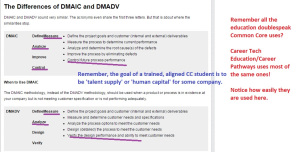IASSC (International Association for Six Sigma Certification) is a third party in the field of workforce credentials. If you’re not familiar with how credentials play into Common Core, think WorkKeys assessments (from the ACT, Inc. folks), Career Tech Ed, and THAT arm of the CC Machine. What’s interesting to note is this credentialing company has this tag line,
“THE Universal Certification”. Unlike “WorkKeys” which is used in aligning your students academic path (for those in 12th grade and under; whereas for those beyond 12th, the assessment is used to pigeonhole one in a job), IASSC uses classes of certification that sound like a karate class. Green Belt certified, Yellow Belt, and the best, Black Belt. Or you could go for the “Get Lean Six Sigma Certified” for your workforce career.
Belts…Binding You to a Job:
The Yellow Belt Worker: Is considered a basic level professional. This worker bee will sit through a 1 and 1/2 hour exam. This proctored exam contains 60 questions, is offered in over 100 countries and to date, and given in 8,000 testing centers. The goal? Can this worker be a great team member or lead small projects? (for more: http://www.iassc.org/six-sigma-certification/yellow-belt-certification/)
The Green Belt Worker: Is considered suitable for leading projects. This exam has less questions, but the time to assess is expanded to 3 hours. Like the Yellow Belt, over 100 countries and 8,000 testing centers. (see: http://www.iassc.org/six-sigma-certification/green-belt-certification/)
The Black Belt: this successful assessed worker will be different than the yellow or green belts (these are for part-time workers) in that they will be suited for full-time employment. The candidates are considered leaders of teams. Testing centers and countries which offer this are the same as the others.
The Six Sigma: not a ‘belt’, but an on-demand approach to high stakes job assessment initiatives. Here’s a quote, “IASSC is now offering a breakthrough approach to high-stakes certification testing. Facilitated completely and available online 24 hours a day, 7 days a week, 365 days per year.” Then, “IASSC provides multiple avenues for achieving your Black Belt, Green Belt and Yellow Belt Certification or integrating the IASSC Lean Six Sigma Certifications into your initiatives, programs and offerings.”
Enter Pearson Vue:
If you don’t know this branch of the Common Core Machine, you should. Why? Each year millions of people take exams or assessments through them. Working with over 400 credential owners (meaning those groups in charge of setting up credentials are worth, etc.), Pearson, as we know, has us covered. Here’s an excerpt, “From downloadable practice tests to high-stakes, proctored exams that require the industry’s most secure testing environments, Pearson VUE is the leader in computer-based-testing — and much more.” So, since we know Pearson’s record of massive profits with Common Core alignment how does it connect to the IASSC? PeopleCert. PC is a global ‘leading player’ in the certification industry. Here’s the sales pitch straight from Pearson’s website:
“Get certified today for the globally recognized project management and ITSM qualifications
Boost your resume with a PEOPLECERT certification! PEOPLECERT exams via Pearson VUE currently include:
- ITIL® Foundation exam (English)
- PRINCE2® Foundation exam (English)
- PRINCE2® Foundation exam (German)
- MSP® Foundation exam (English)
- M_o_R® Foundation exam (English)
- MoP® Foundation exam (English)
- IASSC Lean Six Sigma – Yellow Belt
- IASSC Lean Six Sigma – Green Belt
- IASSC Lean Six Sigma – Black Belt”
What’s an “ITSM”? It stands for “Information Technology Service Management”, it is usually coupled with ITIL (Information Technology Infrastructure Library). If you want to understand how these factor into all the assessments, certifications, think about how much in CCS is pushing digital learning, coding classes, and even data mining.. (a good website of information is http://www.itgovernance.co.uk/ {Note: you can even find publications for taking all the information from silos to implemented programs and services!} If you’d like to see more from Pearson’s Vue website about PeopleCert, http://www.pearsonvue.com/peoplecert/ If you wish to go straight to the PeopleCert website, http://www.peoplecert.org/en/Pages/Peoplecert-Home.aspx {Be sure to note which well known CCS corporations are in the thick of things.} If you wish to see what other assessments PearsonVue is in control of, http://home.pearsonvue.com/About-Pearson-VUE/Discover-Pearson-VUE/Pearson-VUE-businesses.aspx {Note, there’s the GED and many others}
Why is this a big deal? If you look a bit behind all the ads about credentials, better careers, ease of access to take an assessment, you’ll find things like this, from PeopleCert’s CSR webpage, “Our goal is to act as a responsible corporate citizen and as such our commitment to sustainable development is an integral part of our business strategy.” This is followed by this juggernaut paragraph,
“Fully aligned with the EU strategy for Information Society to make IT and Communications technologies accessible to all, PEOPLECERT focuses on 3 key initiatives:
-
In cooperation with national institutions, PEOPLECERT free ECDL and City & Guilds certifications to teenage offenders, offering support and training for their re-induction to society.
-
In addition, PEOPLECERT’s systems have been designed to include the Automated Test Evaluation facility, so that visually impaired individuals can take any PEOPLECERT exam.
-
GetBusy: Developed by PEOPLECERT Microsoft and the Hellenic Professionals Informatics Society (HePIS) to boost the skills of young people and improve their employment opportunities. Part of Microsoft’s Youthspark Global programme, getbusy.gr was designed to help young people aged 18-27 test their skills through an online quiz and improve their know-how through an informative portal which offered ‘How to’ tips on areas such as CV and interview techniques, presentation skills, basic principles of entrepreneurship and fundraising techniques, as well as on basic ICT skills based on the globally recognized ECDL certification. “
The Six Sigma/Lean Six Sigma:
If you’re not familiar with “Lean Six Sigma” it’s a business model based on the “Six Sigma”. The biggest difference, the lean one is based on a model to reduce waste. Now, if you’re talking waste as in using too much paper, that’s one thing, but remember..what are these credentials and assessments measuring? It’s not paper..IT’S People!! One of the best resources for the use of Lean Six?? From IBM! (gee, another CCS supporter, profit maker). The paper details how IT (information technology and those who are in charge can collaborate, streamline and align, have businesses go in and measure or monitor any data they choose). See: http://www.redbooks.ibm.com/redpapers/pdfs/redp4447.pdf
‘Six Sigma’ found its start in 1986 from Motorola before it was moved to GE in 1995. The basics were to apply to manufacturing using an empirical method of people. The mastermind creator? Jack Welch. McGraw-Hill Publishers (more CCS profit makers) has a book that details Six Sigma. Called the “Six Sigma Handbook” by Thomas Pyzdek and Paul Keller. ISBN# 9780071623377
Related information:
The design is you have two similar models that can become a part of your credentialed path, the DMAIC or the DMADV via the Six Sigman (either in full form or lean form). Where to two models are almost in total agreement…using only fact based information..NO intuition is needed. Where the two disagree the most…levels of control. Here’s what a website I found explaining the 2 shared; see below and click to enlarge the graphic.

Source for the above related information: http://www.isixsigma.com/new-to-six-sigma/design-for-six-sigma-dfss/dmaic-versus-dmadv/
How CC benefits from Six Sigma:
Jack Welch, that’s how. Common Core Institute is another. Daily Censored wrote about all of the connections, see: http://www.dailycensored.com/get-a-black-belt-in-common-core-curriculum-implementation/ Here’s an excerpt, “Jack Welch. Welch was affectionately known as Neutron Jack, for his policy of getting rid of employees at General Electric while leaving the buildings intact. After his retirement from GE, New York City schools chancellor Joel Klein tagged Welch as chief advisor to a new academy to train principals. Caroline Kennedy, then-chair of the city schools fundraising effort,, said corporate heads were eager to chip in $30 million here and there for this venture. ”
Link to the Common Core Institute: http://commoncoreinstitute.org/cart.aspx
Link to the C2 Collaborative (also a part of the CCI): http://c2ready.org/
Note: since many teachers are being run through the Six Sigma models, you’ll have to factor in the universities which offer these educational degrees! The Daily Censored article gives you two. University of Ohio and University of California. I’m sure there are more.
Closing:
I truly hope that each of you anti Common Core warriors will use the above information to help stress to our legislators WHY Career Tech Ed/Career Pathways/Workforce aligned CC IS not only un-American, it’s downright playing right into the hands of the loss of individuality for our students. As I’m sure you’re tired of me saying this every time this subject comes up, but I’ll state it again..it matters NOT where our students learn, traditional schools or home; young students or older…ALL will be ensnared. Look at all the evidence and decide how you will get involved in this battle.


6 thoughts on “FTF Tuesday: IASSC..Universal Certification”